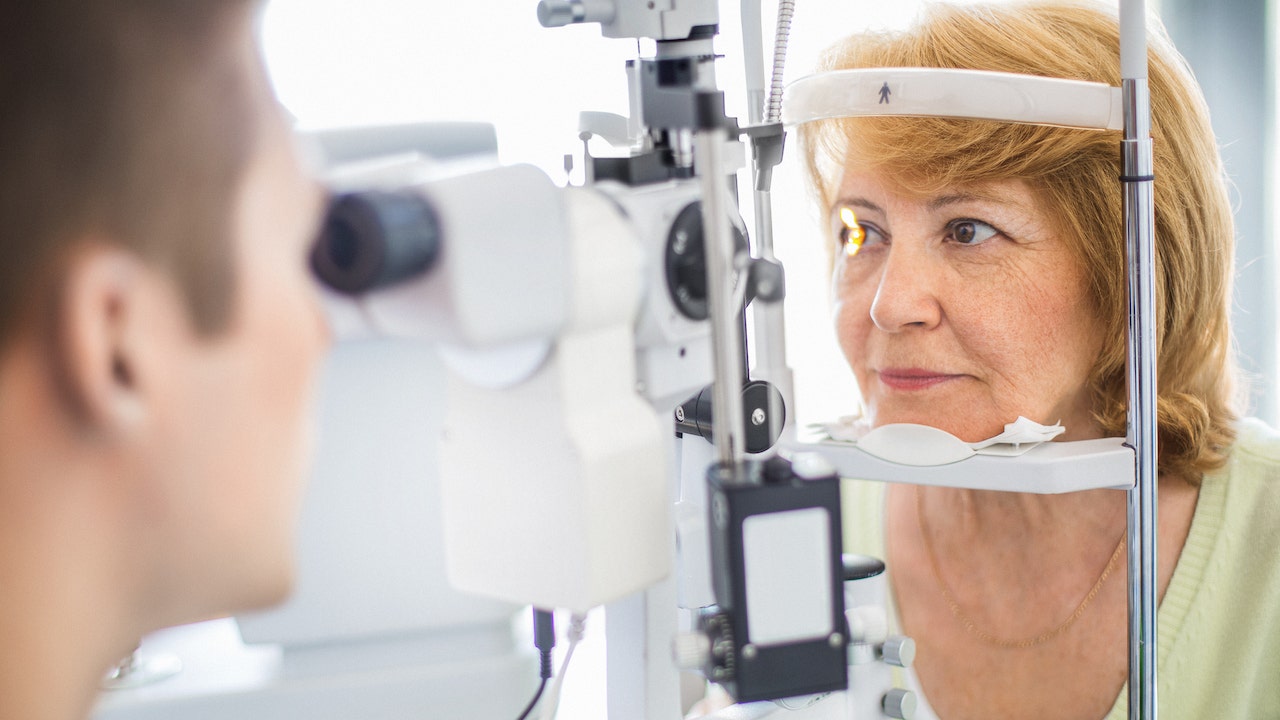Health
Vision problems could mean higher dementia risk, study finds: ‘Eye health and brain health are closely linked’

Older adults with vision problems may be more likely to develop dementia, a new study published in JAMA Ophthalmology has found.
Researchers at the University of Michigan, Ann Arbor analyzed data from the 2021 National Health and Aging Trends Study, which showed a link between all types of vision problems — distance acuity, near acuity and contrast sensitivity — and a higher prevalence of dementia, including Alzheimer’s disease.
Distance acuity (visual acuity) is a measure of the clarity or sharpness of vision from 20 feet away, according to the American Optometric Association.
This is usually tested by having the person read letters on a Snellen chart.
POPULAR CONTACT LENSES COULD CONTAIN TOXIC ‘FOREVER CHEMICALS,’ NEW STUDY FINDS
Near acuity is a measurement of how well someone can see something up close.
Contrast sensitivity measures the person’s ability to distinguish between an object and the background it is set against, or to differentiate between two similar colors.
Older adults with vision problems may be more likely to develop dementia, according to a new study published in JAMA Ophthalmology. (iStock)
The more types of vision problems a person has, the higher the chances of dementia, the study findings stated.
The study included national data from 2,967 participants aged 71 and older.
“We hypothesized that visual impairment would be associated with dementia because prior studies found an association,” said lead study author Olivia Killeen, M.D., clinical lecturer for ophthalmology and visual sciences at the University of Michigan, in a statement to Fox News Digital.
“Loss of visual stimulation will lead to withdrawal and less mental engagement.”
“Eye health and brain health are closely linked in older adults,” she added.
“This study is unique because it used up-to-date, objectively measured visual acuity (meaning participants all had their vision tested),” she went on.
“This allowed us to analyze the associations between visual acuity and dementia.”
Vision problems largely preventable, say experts
Although eye health and brain health are closely linked in older people, the good news is that most vision problems are treatable, Killeen said.
“For example, cataracts are one of the main causes of visual impairment in older people, and vision loss from cataracts can be reversed with cataract surgery,” Killeen explained.
“Because visual impairment is associated with dementia, treating vision problems may be one key to reducing the risk of dementia.”

A Cedars-Sinai study found in March that early signs of Alzheimer’s disease can be detected in eye exams. (iStock)
The study did have some limitations, she pointed out.
The researchers did not have information on the causes of visual impairment, which means they couldn’t study the association between specific eye conditions — such as cataracts, glaucoma and macular degeneration — and dementia.
BE WELL: GET REGULAR EYE EXAMS TO PROTECT VISION AND CATCH WARNING SIGNS EARLY
“Randomized controlled trials are needed to measure the impact of treating vision problems on dementia,” Killeen said.
The results are consistent with previous research showing a link between sensory impairment and higher risk for dementia, agreed Dr. Gary Small, chair of psychiatry and behavioral health physician-in-chief at Hackensack University Medical Center in New Jersey.

“Getting routine eye care is important for early diagnosis and treatment of vision problems,” said the lead author of a new study. (iStock)
Small was not involved in the University of Michigan study.
“Mental stimulation keeps neural circuits active and strong, which protects the brain from age-related declines,” he told Fox News Digital.
“Loss of visual stimulation will lead to withdrawal and less mental engagement.”
CLICK HERE TO SIGN UP FOR OUR HEALTH NEWSLETTER
Given this recent study’s large sample size and “objective measures of visual impairment,” Small said the results are particularly compelling.
“It’s important for anyone, especially older adults, to regularly check their visual acuity and correct deficits to optimize quality of life and protect against dementia,” he said.

The more types of vision problems a person has, the higher the chances of dementia, the study findings stated. (iStock)
Added Small, “The bottom line is that the old adage, ‘Use it or lose it,’ applies not just to physical health but to cognitive health as well.”
Protection and prevention are key to improving outcomes, both visual and cognitive, Killeen agreed.
“Getting routine eye care is important for early diagnosis and treatment of vision problems,” she said.
“The American Academy of Ophthalmology recommends that people 65 and older get routine eye exams every one to two years.”
“It’s important for anyone, especially older adults, to regularly check their visual acuity and correct deficits to optimize quality of life and protect against dementia.”
As Fox News Digital previously reported, a Cedars-Sinai study found in March that early signs of Alzheimer’s disease can be detected in eye exams.
EARLY ALZHEIMER’S DISEASE COULD BE DIAGNOSED THROUGH EYE EXAMS, NEW STUDY SUGGESTS
Patients who had mild cognitive impairment or Alzheimer’s disease were found to have higher amounts of amyloid beta 42, a protein that forms the “plaques” that build up in the brains of people with Alzheimer’s — as well as cells called microglia, which are also associated with progression of the disease — in their retinas.

Health
3 Readers Lost 448 Lbs—Here Are the Tips They Wish They Knew Sooner

Use left and right arrow keys to navigate between menu items.
Use escape to exit the menu.
Sign Up
Create a free account to access exclusive content, play games, solve puzzles, test your pop-culture knowledge and receive special offers.
Already have an account? Login
Health
Couples who cuddle before sleep reap key health benefits, study reveals

NEWYou can now listen to Fox News articles!
Snuggling with your partner could be a win-win for your health.
Cuddling at night promotes more secure attachment between partners and lowers stress levels, according to a new study published in the Journal of Social and Personal Relationships.
Researchers from Auburn University examined data from 143 heterosexual “bed-sharing” couples, analyzing associations between physical closeness at sleep onset, perceived stress, attachment insecurity and sleep disturbance.
MOST SLEEP-DEPRIVED CITIES IN US REVEALED IN REPORT: WHERE DOES YOURS RANK?
Factors including daytime sleepiness, income, age, relationship length, sleep diagnoses and whether children or pets sleep in the bed were also considered.
The results revealed that couples who assumed a physically closer position upon going to sleep were indirectly linked with “lower couple insecure attachment” (when they have trouble connecting emotionally) and lower stress.
Couples who cuddle are less stressed and more secure, according to a new study. (iStock)
The researchers found no “significant” associations between physical closeness at sleep onset and the chances of sleep disturbance.
While stress was found to be lower among cuddlers, the research found that cuddling did not increase sleep quality.
The researchers concluded that physical closeness at sleep onset “may be a promising and amenable avenue for improving relational and physiological well-being.”
HERE’S WHY 90% OF AMERICANS DON’T SLEEP THROUGH THE NIGHT, ACCORDING TO EXPERT
Sleep expert Wendy Troxel, PhD — a RAND Corporation senior behavioral specialist and licensed clinical psychologist in Utah — shared with Fox News Digital how these findings highlight the “vital role” that shared time and physical touch play in emotional well-being.
Troxel, author of the book “Sharing the Covers: Every Couple’s Guide to Better Sleep,” commented on the “interesting” finding that cuddling did not influence sleep quality.

A sleep expert says, “The simple act of cuddling before sleep likely triggers powerful psychological and physiological responses.” (iStock)
“This suggests that it’s the moments spent together before falling asleep — not necessarily sharing the entire night — that have the greatest positive effect on a relationship,” said the expert, who was not involved in the study.
“The simple act of cuddling before sleep likely triggers powerful psychological and physiological responses, such as increased emotional security and the release of oxytocin — the ‘bonding hormone’ associated with intimacy.”
HEAT EXPOSURE LINKED TO BETTER SLEEP, EXPERTS SAY — HERE’S WHY
These effects help reduce stress and deepen connection, which makes pre-sleep cuddling a “meaningful ritual for emotional health,” Troxel said.
“Whether you and your partner sleep together or apart, don’t skip the cuddle before bed,” she advised. “Even brief moments of closeness can enhance your relationship and overall well-being.”
While the study found that most couples sleep in the same position as their partner, 36.3% reported not touching or cuddling at night.

While the study found that most couples sleep in the same position as their partner, 36.3% reported not touching or cuddling at night. (iStock)
Those who did touch reported sleeping back to back (19.6%), having some contact, like touching an arm or leg (23.1%), spooning (13.3%), intertwining (4.2%) and sleeping face to face (3.5%).
Study co-author Josh R. Novak, PhD, associate professor at the Auburn University Department of Human Development and Family Science, confirmed in a statement to Fox News Digital that the more physically close position couples are in, the more feelings of “relational safety” were present due to lower stress.
CLICK HERE TO SIGN UP FOR OUR HEALTH NEWSLETTER
“Sleep is one of the most important ways we can manage our physical, relational and mental health,” the researcher said.
“Research has substantiated that sleep and relationship functioning are bidirectional and cyclical — meaning that bad sleep can negatively impact your relationship, and difficult relationship dynamics can lead to worse sleep.”
“Sleep is one of the most important ways we can manage our physical, relational and mental health.”
Novak added that non-sexual physical affection has generally been deemed “critical” for relationships, but there seems to be more “emotional and relational benefit” when there’s full-body contact.
“My study suggests that cuddling with a partner can be both a barometer of how a relationship is doing and a way to maintain or repair a relationship, as well as lower stress levels,” he said.

Cuddling with a partner can test the strength of a relationship and help mend it, the study’s lead researcher suggested. (iStock)
The researchers did not study how much time was spent in a cuddling position, leaving Novak to be “skeptical” of whether it leads to sleep disturbances.
“What happens most often is that cuddling only happens for a bit until both partners fall asleep, but there could be a select few that cuddle throughout the whole night,” he said.
For more Health articles, visit foxnews.com/health
“My hunch is that most use cuddling to induce sleepiness and the feeling of safety and to reduce stress and anxiety, and that afterward either their body temperature increases too much, or there is discomfort and the need to shift around becomes necessary.”
Novak encouraged couples to cuddle if stress levels are high, as it’s a nonverbal way to feel “secure and safe.”
“Although research needs to substantiate this further, it might also imply that, in the face of conflict during the day that is not solved or repaired … cuddling might be a way to start that process and move toward repair,” he added.
Health
Dr: Tirzepatide May Be Even Better Than Ozempic for Weight Loss

Use left and right arrow keys to navigate between menu items.
Use escape to exit the menu.
Sign Up
Create a free account to access exclusive content, play games, solve puzzles, test your pop-culture knowledge and receive special offers.
Already have an account? Login
-

 News1 week ago
News1 week agoVideo: Faizan Zaki Wins Spelling Bee
-

 Politics1 week ago
Politics1 week agoMichelle Obama facing backlash over claim about women's reproductive health
-

 Technology1 week ago
Technology1 week agoOpenAI wants ChatGPT to be a ‘super assistant’ for every part of your life
-

 Movie Reviews1 week ago
Movie Reviews1 week agoThe Verdict Movie Review: When manipulation meets its match
-

 Technology1 week ago
Technology1 week agoWhy do SpaceX rockets keep exploding?
-

 Movie Reviews1 week ago
Movie Reviews1 week agoTornado movie review & film summary (2025) | Roger Ebert
-

 World1 week ago
World1 week agoTwo killed in Russian attacks on Ukraine before possible talks in Turkiye
-

 Finance1 week ago
Finance1 week agoHere's what will boost your feeling of financial well-being the most, researchers say














